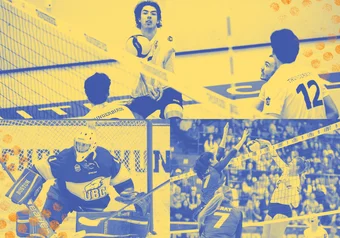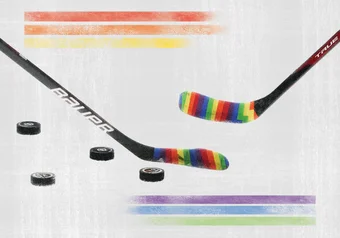After almost a week straight of rain, the sun has finally come out. East Mall is teeming with students emerging from hibernation. Some walk in huddles, others sprawl out on the benches and grassy patches.
The thumping dribble of a basketball is barely audible amongst the chatter, petering out as the ball rolls off.
Henry Chang stands with his arms outstretched and calls out.
“Ball.”
A second-year business and computer science student, Chang has been playing basketball since grade six. After a break in high school to focus on school, he resumed in his first year of university.
“It's like my fun time. So anytime I get fun time, I try to squeeze it in,” he said.
Chang also plays in UBC Rec's indoor intramural basketball league in the SRC, but finds that pickup still has its draws.
“If you're gonna go play [indoors], you're gonna try to win. You're not messing around, shooting casually. Whereas outside, with this court, I find that it's much more casual. It's more relaxed — you can do whatever you want.”
Depending on the time of day and the weather, the number of people he’ll play with differs, changing the form of pickup.
“If you play basketball enough, you realize that one on ones versus two on twos versus five on fives are all different types of games,” he said.
According to him, one on one is the most flexible and comfortable, two on two is slightly more competitive and five on five is very team-oriented.
“It's different dynamics, I guess.”
On this particular day, the informal court — the small, unmarked stretch of concrete with by two hoops near the HEBB building — is relatively empty. Two other students practice layups as we chat. For Chang, this space outside the Nest provides a respite between work and school.
“I treat this like my third place here,” he said. “This is the one place where I can just relax and hang out.”
These hoops are the result of the 2010 UBC Vancouver Campus Plan, according to Joanne Proft, associate director of community planning at UBC's Campus + Community Planning.
From an urban planning perspective, spaces for informal sports are integral to a healthy community.
“There's real dividends that we see — reducing healthcare costs, increasing safety in communities … We really see it as an important ingredient in creating a complete and sustainable community,” said Proft.
And, despite their humble appearance, the hoops outside the Nest still get a lot of use.
“By the very nature of pickup sports, oftentimes you don't need a lot of infrastructure, or some infrastructure could be temporary or you could change it throughout the year,” said Proft.
The adaptability of pickup sports to existing infrastructure also expands well beyond basketball.
Dr. Gerry Veenstra, a UBC sociology professor and a longtime pickup soccer player, noted that soccer is even less demanding than pickup basketball when it comes to location.
“You just need a field ... We can mark out the contours and the boundaries of the pitch ourselves,” he said. “So really, park space is the most important part of the infrastructure that matters for us.”
Veenstra has played pickup soccer in Vancouver since 1999. He’s also played league soccer — with referees, specified positions, formal uniforms and regular teammates — but has found that he prefers pickup.
“In pickup soccer, it's a different team every week,” he said. “There are no implications, there are no standings, no one's recording anything. It's just kind of spontaneous. It's located in this moment in time. And that's it.”
In addition to the benefits of regular exercise, pickup soccer is also a way for Veenstra to participate in his community.
“Most of my closest friends are actually from my pickup soccer community. It's enabled me to foster friendships and social connections with a wide variety of other people from Vancouver.”
After 25 years of playing pickup soccer in this city, Veenstra is still passionate about the game.
“What's lovely about pickup is that it allows older people like me to continue playing,” he said. “Many of the other players are of my age. I can compete against other older people, and still experience the joy and the glory of ... playing the game and accomplishing things in it.”
Back on campus, it’s another bright sunny afternoon. Near the Nest, a handful of students have shed their layers and gathered underneath the hoops. Every now and then, someone else walks up, handshakes are exchanged and the teams shift to absorb the new player.
“Everyone knows [school] can get annoying and frustrating and stressful. So for some people, not everyone, but for me, this is a way to kind of let that all out. Take your mind off and just come have fun. Get some exercise outside,” said Matthew Gillies, a fourth-year statistics student.
Earlier, he and a friend had been demonstrating how to do a Euro step to a couple of other players.
“You want everyone to be pretty good. It's more fun to play. So helping out everyone else doesn't do any harm, of course, so why not?” He shrugged with a smile.
In the crowd on the court, which has now doubled in size, I catch a glance of Chang again.
Gillies sits on the side taking a break, adjusting his laces as he looks out at the commotion.
“Everyone here is super nice,” he said. “I'll have at least three people come walk by, ask for a shot. And we'll always give them the ball, let them shoot, if they want to learn. The more people playing the better.”
Share this article
First online





